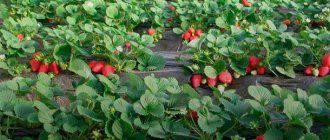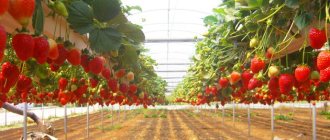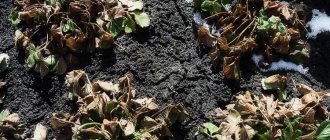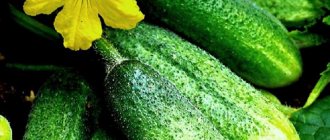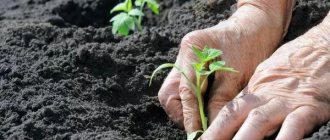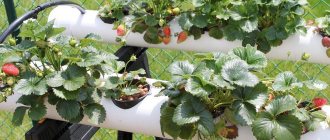Greenhouse strawberries - selecting the optimal varieties and hybrids
High-quality planting material is already half the success, especially if we are talking about seedlings. Each variety and hybrid has a certain potential yield, more than which it is simply impossible to obtain even under ideal care conditions - you can’t jump over your head. Therefore, if you seriously want to grow berries, you need to choose the right seedlings that would meet the conditions of your greenhouse and also satisfy all your wishes. Today there are more than 250 different varieties, including extremely sweet, sour, large-fruited and others. Let's look at the most popular options for industrial cultivation.
Albion. The most popular variety of American selection, which has been extremely popular among domestic gardeners for several years. Despite the fact that strawberries are a day-neutral crop, they bear fruit no worse than remontant varieties, and from the end of May you can enjoy the delicious berries. It finishes bearing fruit approximately on November 15-25, when the air temperature drops to 0 degrees. The fruits are small, up to 25 grams, but the average weight is 12 grams. Strawberry was developed by crossing Cal94.16-1 and Diamante. The latter variety was very popular in the early 90s.
Brighton. Remontant strawberries are distinguished by relatively high yields and large mass of fruits. 1 berry can weigh up to 150 grams, and the average weight is 80 grams. Thanks to such indicators, it is very possible to collect 100 c/ha (100 kg from 1 hundred square meters), which is why Brighton is one of the most famous industrial hybrids. The fruits are easily transported and stored for a long time, as they have low water content.
Queen Elizabeth 2. Anyone who has not yet come across this variety of remontant strawberry should definitely have it in their greenhouse or in open ground. It is No. 1 in the Russian Federation and many European countries due to its productivity. It has a dessert purpose; the fruits are very sweet, large and numerous. From 1 bush during the entire fruiting period you can collect up to 4 kg of berries! This is approximately 320-350 c/ha or 350 kg from 1 hundred square meters! The only disadvantage of Queen Elizabeth II is its poor transportability. Transporting it is extremely inconvenient and difficult, since the berries are very juicy and can be choked; it is impossible to lay them in a thick layer. An excellent variety for freezing in the freezer and for drying, as the density of the pulp is high.
Diva F1. Some of the best remontant hybrids in Russia. It was bred in Holland, but has been successfully grown on our territory for 10 years and is perfectly acclimatized. Withstands severe frosts in winter and is not susceptible to most diseases. The hybrid is very resistant to various types of spots. If we talk about taste, then Primadonna has a very high sugar content, which is why gardeners liked it. Despite the relatively low yield of 80 c/ha, it is grown in almost every nursery. It has increased durability and is easily transported over long distances.
There are other high-yielding hybrids and varieties of strawberries for indoor soil: Capella, Sakhalin large-fruited, Tristan, Charlotte, Diamant, Arapahoe and the like. But they are much more sensitive to many diseases, inferior in taste to the varieties described above, and also have significantly lower yields. They are planted mainly for their own needs and for variety in a greenhouse or garden bed.
Advantages of a greenhouse
A completely different result can be obtained if you grow strawberries in a greenhouse on your personal plot. The advantages of growing strawberries and strawberries in a greenhouse are obvious. This will allow you to obtain several harvests per year , significantly reducing the risk of plant diseases and its dependence on weather conditions.
By observing the desired temperature, humidity and watering, you can grow berries that have the most optimal taste and external qualities, while maintaining maximum beneficial properties.
How to plant bushes correctly - Russian and Dutch technologies
There are several planting methods. Depending on which one you use, the yield of berries will vary. Let us first consider the usual, “Russian” landing technology.
STEP 1
Soil preparation
The entire area of the greenhouse is divided into 2 parts lengthwise (or more, depending on the width of the structure, usually 1 lane - 1 meter) between which a technical lane is left for movement. It is filled with expanded clay chips or small crushed stone 5-6 cm, then sand 8-10 cm. Fertile soil 7-8 centimeters thick is laid on top, after which superphosphate and ammonium nitrate are added in an amount of 10 grams per 1 square meter.
STEP 2
Preparing and planting seedlings
Holes are made in the soil 8-10 centimeters deep at a distance of 30 centimeters, after which strawberry rosettes are planted, in a checkerboard pattern or in a row. Very often, oilcloth or agrofibre is used to avoid weeds and retain as much moisture as possible, but in a greenhouse you can do without this, since excessive moisture can lead to rotting of the roots and stems.
STEP 3
Caring for bushes and subsequent soil treatment
As the soil becomes depleted, potassium fertilizers, superphosphate and ammonium nitrate are applied, and nitrogen supplements are used for the first 2 months to build up the vegetative mass of the plant. Abundant drip watering is carried out, almost daily for the first 3-4 weeks, while the bushes take root, and after 5-8 days in the subsequent period.
This was a standard planting scheme, but if you want to get more yield and optimally use the space in the greenhouse, then Dutch technology is offered to your attention. What is its essence and differences from domestic methods of growing strawberries? Let's take a closer look.
- Seedlings in a greenhouse are not planted in the soil, but in pots that are installed in several tiers. Depending on the height of the worker and the characteristics of the bushes, there can be up to 8 such tiers. Thus, you save space - up to 50 or more bushes fit on 1 square meter! This allows you to significantly increase the yield per unit area, and in a small greenhouse of 100 square meters you can fit 30-40 acres of berries!
- It is convenient to collect the fruits and they will not get dirty in the dirt, as in the garden, because all the fruits will hang from the flower pot and will not touch anything. Thus, you will save a lot of time during subsequent processing of your crop, and immediately after harvesting it will have a marketable appearance.
- Growing strawberries indoors using Dutch technology allows you to get much higher yields not only per unit area, but also per bush, since the plant receives enough light and oxygen. Moreover, the pots are much higher than the ground and the cold air, which always sinks to the bottom, does not reach them. Growth and productivity increase significantly, and such greenhouses can be heated much less - additional energy savings during the cold season.
- Watering such a “bed” is more economical. If you are interested in how to grow strawberries in a greenhouse at minimal cost, be sure to pay attention to Dutch technology. In pots, water evaporates much longer than in the ground, especially if they have proper drainage. Thus, if you apply drip irrigation with hoses to all pots, you can spend 50-70% less water on watering your plants.
Both regular and remontant varieties of strawberries are suitable for growing using Dutch technology. The only limitation is that the bushes are too tall. For example, Queen Elizabeth 2 requires large vessels for growing, since its root system is 6-7 times larger than that of ordinary “rows”. However, these are all working moments and, if desired, you can even grow a tree in a pot.
There is also growing in bags - this is the Russian answer to the Dutch technology, where ordinary plastic bags are used instead of ceramic pots. The essence of this method is very simple: special soil is prepared (similar to the methods described above, only without drainage), which is poured into a plastic bag, after which holes are made on top, and seedlings are planted. One of the main advantages of this method is cost-effectiveness, because one such “vessel” will cost 8-10 rubles and is intended for 4-5 bushes. Disadvantages include the inconvenience of processing and watering (you need to use sprayers, waste gallons of water), as well as an unsightly appearance.
Preparing seedlings
There are two options for obtaining seedlings:
- purchasing ready-made seedlings in specialized nurseries;
- self-growing seedlings from seeds.
The first option is the most convenient and fastest. Special farms engaged in growing seedlings can offer a good selection of strawberry varieties aimed at growing at home. It is important to note here that you should not buy seedlings from unknown sellers, as there is a high probability of purchasing a variety that is completely unsuitable for growing at home.
Growing strawberry seedlings from seeds yourself is also not particularly difficult. There are strawberry seeds of special indoor varieties on sale. To obtain seedlings, purchased seeds are sown in well-moistened soil, the seeds are sprinkled with a layer of soil on top and compacted. Containers with seeds are covered with film until germination. When the seedlings have appeared, the seedlings must be placed in well-lit windows. The seedlings will be ready to be transplanted to a permanent location when two true leaves appear on it.
Strawberries in greenhouses - planting time and temperature conditions
Many people believe that seedlings can be planted in the middle of winter and that the berries will appear much earlier, but this is not at all true. Strawberries are a plant that responds to changes in daylight hours and the best planting time for them is the end of February and the beginning of March. This is determined by even more factors, such as temperature. It is necessary to maintain up to +22 degrees and at least +12 indoors so that the bushes grow and develop normally. At relatively cold air temperatures, they will not throw out mustaches and, especially, form fruits.
For the first days after planting, it is advisable to maintain +25 degrees so that the seedlings take root well and begin to take additional roots. Then you can lower the temperature to +15 as the bush takes root. In unheated greenhouses, this should be done at the end of March, when there is no frost, since most varieties may not survive even -5 degrees after the formation of mustache and color. If you are going to get solid harvests, then there is no need to rush, because the quieter one gets the most.
Planting seedlings in a permanent place
Each plant is planted in an individual container. For normal development, a strawberry bush needs a volume of soil of at least 3 liters. Planting containers must have good drainage, since stagnant water is detrimental to strawberries. Drainage can be made of expanded clay or pebbles, or broken brick.
The rhizome should not be buried too deeply into the soil, but it should not protrude above the surface of the ground either. If the roots are too long, it is better to trim them. They should not be bent inside the landing recess. There is a growth stimulator called heteroauxin. Its use will allow you to quickly restore the root system of a transplanted plant. Two tablets of heteroauxin are dissolved in 10 liters of water. The seedlings are kept in the resulting solution for three hours before planting. The same solution can be watered after planting. This method allows you to increase the survival rate of plants.
Pollination - is it necessary and how to do it?
Strawberries in a greenhouse are quite problematic in terms of pollination - insects, wind or heavy rainfall are needed for their fertilization, but all this is not available indoors. How to be? There are several ways to pollinate bushes, let’s look at the main ones.
- Make the wind. This is the simplest method with pollination efficiency of up to 90%. To do this, you will need several fans that will create air flows in different directions and carry plant pollen. A greenhouse of 100 square meters requires up to 3 fans; they must be turned on during the flowering period of the bushes, for only a few hours a day. The situation is somewhat more complicated in the case of remontant varieties - they bloom almost constantly. In this case, it is necessary to “pollinate” 2-3 times a week for 3-4 hours a day.
- Get insects. The best thing is a beehive. Disadvantages: insects sting, bees cannot be touched during the wintering period, there is very little space for flight, after a couple of days they must be released into the wild, the hive cannot be moved so that the insects do not get lost. The advantage is high-quality pollination, at least 95%.
- Make a shower. If you have strong sprayers, you can water the bushes. The disadvantage is the low process of flower fertilization - no more than 45%, since a lot of pollen will be washed away with water.
- You can also simply create a draft in the greenhouse by opening 2 windows on opposite sides. Ideal if it’s warm outside and there’s a moderate wind. Important: if the greenhouse has a weak frame or film, you should not create a draft, as the structure may open up or fall . Also, you should not ventilate at low temperatures (less than +7 degrees), as you will do more harm to the strawberry flowers and they will fall off.
Pollination is necessary and without it, counting on a large harvest of berries is simply pointless. For even greater efficiency of the process, it is necessary to ensure that during flowering the temperature is not lower than +15 degrees and no more than +25, since the stickiness of pollen, in this case, drops very quickly.
Preparing the soil mixture
To grow strawberries, you can buy a ready-made soil mixture at a specialty store or prepare it yourself. Strawberries do not have any special requirements for the composition of the soil, so in the absence of a special mixture recommended for it, any universal mixture intended for vegetables or flowers is suitable.
When preparing the soil mixture yourself, the following components are taken in equal proportions:
- forest land (preference for coniferous forests);
- sand;
- humus;
- peat.
To increase the fertility of the mixture, you can add wood ash at the rate of 1 cup of ash per bucket of peat.
To ensure sufficient looseness of the soil, sawdust can be added. Add 3 parts of sawdust to 10 parts of soil mixture. Sawdust should be pre-prepared by soaking it in a special solution for 3 hours. Solution composition:
- water – 3 l;
- urea - 2 tbsp. spoons.
It is not recommended to use soil taken from the garden to grow strawberries at home. This advice is explained by the fact that in the garden the soil may be susceptible to infection by root nematodes.
If the mixture was prepared independently, it is recommended to pour it with a solution of potassium permanganate of medium concentration and let it sit for a week.
At the final stage of soil preparation, it is moistened with a solution of the following composition:
- water – 3 l;
- liquid mullein - 1 cup;
- copper sulfate - 0.5 teaspoon.
Main diseases and methods of combating them
Inexperienced gardeners believe that a greenhouse is a salvation from many diseases and pests, and the berries in it will be completely safe. In fact, when growing indoors, there will be much more diseases, in particular due to the lack of quality ventilation. Therefore, it is necessary to face troubles head on and know the basic methods of combating the most common fungi, infections and pests.
- White rot. Due to the high relative humidity indoors, white mold may form on the strawberries, which looks somewhat like a very thin cobweb in clumps. The leaves on the plant suddenly begin to lighten and dry out after a couple of days, and the berries in the affected areas rot. The mycelium cannot be eliminated by practically anything, it is very resistant to drying out, so raising the temperature and lowering the relative humidity will do nothing. Control measures are drastic - removing infected berries and leaves and burning them. As a preventive measure, it is necessary to increase the room temperature and install a dehumidifier - most of the fungal spores will die, while others will simply be inactive.
- White spotting. Almost every gardener knows her, since it is very difficult not to meet her. The first symptoms: the leaves become speckled with white, such circles can be up to 8 millimeters, they are brown at the edges, the center is very light, almost white, which is why the disease is called that. It develops, as a rule, during the flowering period of berries, destroying leaves, stems, and sepals. Peduncles may change color and become darker. The disease progresses with abundant watering and high relative humidity in the room, as well as high planting density. It can cause the loss of the entire harvest if you do not fight back in time. Treatment consists of treatment with Falcon, Euparen, or copper sulfate (the proportions are written on the packaging of the drugs).
- Brown spot. An equally common disease, which, in special cases, “mows down” up to 60% of all plants. As a rule, in the first half of the season it does not make itself felt, or appears only on some bushes, and by the beginning of August it begins to progress fully. The leaves darken at the edges and acquire a bright brown color, then darken a little and dry out. The disease is very dangerous not only for the harvest, but also for the propagation of strawberries, as it affects leaves, flowers and even tendrils. The fungus multiplies and hides on the affected plant, and overwinters on it, so the most effective method of control is to remove the affected branches as soon as the fungus is diagnosed. Preventive spraying with Euparen and Metaxylene will ensure increased plant resistance to damage by this type of biological activity.
- Powdery mildew is the greatest enemy of greenhouse plants. At high relative humidity, as well as at low temperatures, it develops exponentially. The disease can be identified by the characteristic white coating that forms on the underside of the leaf blade. After a while, it appears on top and then throughout the plant, including flowers, tendrils and sepals. The leaves curl into a “pipe”, after which they dry out and fall off, the plant stops synthesizing organic substances and dies. You can fight powdery mildew using copper sulfate, soap solution (4%) and Quadrix. But it’s easier to remove infected plants and monitor the optimal humidity in the room.
- Root blight . Very insidious zoospores that are found in the soil infect the root system, mainly at the end of May, when the soil temperature reaches +20 degrees. Gradually, the roots turn red and die. As a result, the plant dries out. It is very difficult to diagnose and, in most cases, gardeners see the problem after “opening” the bush - the roots have turned red and dried out. You can try to determine the symptoms by the leaves - young leaves are much smaller than expected and are too light. Treatment with Quadrix helps by 70%, and the main method of control is to remove diseased plants and improve the health of the plantation.
It is not only unprofitable to treat many diseases, but also pointless, since it will take a lot of time and the bush will not bear fruit anyway. If plants die in isolated cases, then the best way to get rid of the problem is to get rid of the plant itself. If you trace a pest invasion or mass infection, then you need to resort to chemistry and change the conditions in the greenhouse.
Choosing the right soil
Although strawberries are unpretentious in terms of soil type, preference is given to chernozems; a good harvest occurs when grown on sandy loam soil types. Strawberries do not like acidic soils, so it is not recommended to plant them on peat bogs.
Well-groomed beds
- Before planting, it is necessary to prepare the soil and cultivate it, because the larvae of beetles and wireworms overwinter in the soil.
- The proximity of forest plantations to your summer cottage increases the likelihood of soil contamination by larvae of vermin insects.
- In order to disinfect the soil, it is recommended to plant lupine. Its beans contain an alkaloid substance that has a detrimental effect on insect pests.
Remontant garden strawberries grown on black soil
If the area is clogged with perennial grasses, use an ammonia solution (2 liters per hectare). A Roundup solution (3 liters per hectare) will help get rid of weeds. Treatment against weeds is carried out in the fall, after which the ground is plowed. In winter, soil covered with snow will retain moisture well.
Before planting in early spring, harrowing should be carried out with a depth of 15 cm.
Strawberry propagation in greenhouse conditions
25-30 days after the seedlings take root and begin to actively gain vegetative mass, tendrils - generative organs - will begin to appear. In 2 weeks, new rosettes will begin to take root, it is then that it is necessary to water the soil abundantly and raise the temperature to +22 degrees so that the lateral and main roots can take root thoroughly.
After the rosette becomes dense (4-5 stems), it is removed from the soil. To do this you will need pruning shears, a spatula or a wide knife. Using pruning shears, we cut off the tendril at the base of the new rosette from which it appeared and all the new shoots. We also discard subsequent bushes and immediately tear off the tendrils as soon as they begin to appear on the daughter plant. Then use a spatula to dig up from all sides without damaging the roots - it is better to leave more soil on the rhizome. If the ground is dense, then it is more practical to use a knife. We move it to a new hole (first add superphosphate and a growth stimulator) and water it abundantly. After 2-3 days, the plant will “move away”, acquire a dark green color, and begin to actively grow.
Portable beds
In the event that you were unable to prepare beds for strawberries in the fall, you can make so-called “mobile beds.”
- You will need a dark garbage bag. By cutting it into three or four parts and stitching the edges, you will get bags.
- Pour the prepared soil into them and leave until spring. With the onset of warmth, place the blanks on a sheet of slate in a sunny place in your summer cottage. Use a utility knife to make cuts in the polyethylene and plant strawberry seedlings there.
- The soil in such “mobile beds” warms up quickly, and your bushes will soon bloom. They will be harvested several weeks earlier than the usual ripening time for strawberries in your region.
Blank for a mobile flower bed
With this growing method, the berries will be clean, and you won’t have to fight weeds. The mobility of such beds is the main advantage. They can easily be moved to different places on the site and interspersed with other garden crops.
Growing in special bags
Winter storage
While the seedlings are waiting their turn, it is necessary to create favorable conditions for their storage. To do this, we create the necessary light and thermal conditions for comfortable plant growth.
If they are waiting for their turn to be planted in the greenhouse, then they should be covered with covering material. If you are at home on the balcony, then you should carefully monitor the temperature; if it drops below zero, you should turn on an additional heat source - a heater.
Starting from January 15, daylight hours for berry crops should be increased; it should be at least eight hours. For this purpose, additional fluorescent lamps are used. If you want to taste your own strawberries during the May holidays, then starting in March you need to increase the daylight hours to 16 hours.
